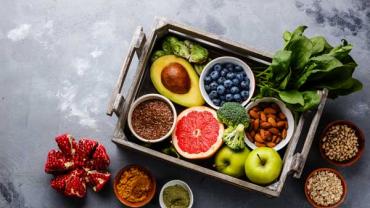
It is well-established in scientific literature how necessary daily vegetable and fruit intake is for our physiological health and wellbeing, but not many people truly understand their importance in the diet. Many doctors often prescribe fruit and veggies (along with more exercise) to many of their patients but don’t always explain why they should eat more of them.
Fruits and vegetables are loaded with antioxidants (i.e., polyphenols, phytochemicals, phytonutrients) which can be measured by their ORAC value. ORAC stands for oxygen radical absorbance capacity, which is a measurement of food, spice, or other nutrient/substance’s ability to quench oxidative free radicals in a test tube. Free radicals and reactive oxidative species (ROS) are synonymous. Essentially, free radicals are unstable atoms or molecules that are produced in normal metabolic processes (e.g., glycolysis, electron transport chain) that have the ability to take electrons from other molecules nearby, causing chain reactions of oxidative stress and damage. Continuous oxidative damage causes inflammation which a significant culprit to many degenerative conditions and age-related diseases.
Most people consider some medical diagnosis of an illness or disease to be a part of “normal” aging. However, it may come as a shock for many to find out that these “age-related diseases” are not inevitable, but rather a sign of unhealthy aging. Cultures living in the Blue Zones - the healthiest cultures with the highest life expectancy around the world - are a testament to the notion that aging does not equate to disease and poor health. Healthy aging is often defined as metabolic age (i.e., the age of an individual’s cells, metabolism) being “younger than” biological or chronological age. A review in the journal Nutrients elucidates how reducing systemic inflammation is the key to longevity and prevention of developing a chronic disease. Risk factors for all-cause mortality and cardiovascular disease (CVD) incidence were studied in elders in the northeastern Icaria Island in Greece. The study found that drinking coffee and tea, fruit intake, and exclusive olive oil use was inversely associated with CVD. Diet and lifestyle factors are the primary determinants of health and are major factors in the longevity of those living in Blue Zones. Diets in the Blue Zones are typically plant-based, high in fiber, high in vegetables, legumes, whole grains, and nuts and seeds, and usually, incorporate locally-caught fish (rich in omega-3 fatty acids) similar to the Mediterranean-style diet.
High ORAC Nutrients
In previous articles, we’ve highlighted a few specific vitamins and dietary compounds in foods that have some of the highest ORAC values. The vitamin E subfractions, specifically delta- and gamma-tocotrienols, have 5.5. and 3 times greater ORAC value than alpha-tocopherol, respectively, contributing to substantially greater health benefits. Cherries and elderberries are two foods that boast high on the ORAC chart, due to their phytonutrient-rich composition, particularly anthocyanins and quercetin. Spinach and lycopene also possess a high antioxidant profile, as well as most other leafy green vegetables. A study published in early 2019 in the International Journal of Molecular Sciences showed consumption of spinach modulated the metabolism of lipids in the liver in fatty-liver induced rats, and that hepatic accumulation of alpha- and beta-carotene and lutein was inversely correlated with serum total cholesterol and blood glucose. Other fruits and veggies include carrots, beets, tomatoes, parsley, broccoli sprouts, kale, spirulina, wheatgrass, chlorella, grape seed and skin, apples, cranberries, pomegranates, blueberries, raspberries, Camu Camu berry, and acai berry.
Many of these high ORAC fruits and vegetables can be condensed and found in supplements in the form of capsules and powders. Powdered greens containing fruit and vegetable blends have become very popular among the health and wellness community, which makes sense because they are loaded with antioxidant-rich phytochemicals that support patients’ optimal health. Densely packed fruit and vegetable powders are wonderful tools, and some would argue essential for patients who do not consume adequate amounts from their diet. Additionally, antioxidant-rich greens powders are helpful for older adults who have limited mobility and those who are unable to prepare meals from scratch; the ease of blending the powder with water or adding it to smoothies can truly make a difference. Greens powders may also help counteract the deleterious effects of a high intake of processed foods for patients who are unwilling to change their current dietary patterns, who take certain nutrient-depleting medications, as well as those who smoke or misuse alcohol.
There are many other compounds, and culinary herbs and spices that have a very high ORAC such as astaxanthin, cinnamon powder, sumac, ground cloves, oregano, turmeric, unsweetened cacao powder, cumin seed, ginger root, nettle leaves, and burdock root. Certain nuts and seeds such as brazil nuts have some of the highest total antioxidant capacity values. Patients may leafy green utilize these spices and herbs in the kitchen and incorporate these foods into their diets to boost antioxidant levels to combat free radicals and oxidative stress that cause systemic inflammation.